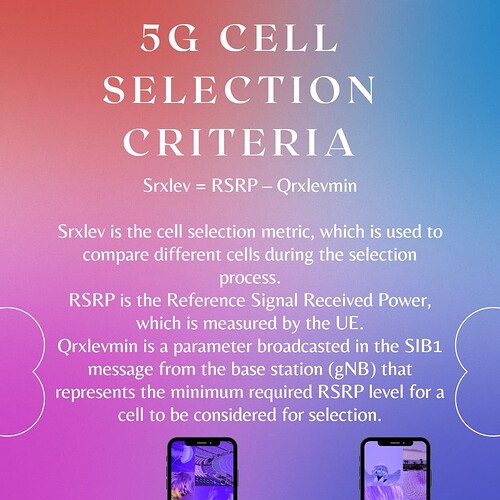![]() Introduction: Cell selection in 5G networks is the process through which a UE (User Equipment) identifies and selects a suitable cell to connect to the 5G network. This is the first crucial step before a UE can avail the network’s services. The process ensures that the UE chooses the best cell for quality communication.
Introduction: Cell selection in 5G networks is the process through which a UE (User Equipment) identifies and selects a suitable cell to connect to the 5G network. This is the first crucial step before a UE can avail the network’s services. The process ensures that the UE chooses the best cell for quality communication.
![]() Cell Selection Process:
Cell Selection Process: ![]() →
→ ![]() The selection process begins when the UE is powered on or when it moves out of coverage area. The UE scans all frequency bands supported by the 5G network and looks for the Synchronization Signal Blocks (SSBs) that contain the necessary system information.
The selection process begins when the UE is powered on or when it moves out of coverage area. The UE scans all frequency bands supported by the 5G network and looks for the Synchronization Signal Blocks (SSBs) that contain the necessary system information.
![]() Synchronization Signal Blocks (SSBs):
Synchronization Signal Blocks (SSBs): ![]() →
→ ![]() SSBs carry vital parameters, such as the Physical Cell ID (PCI), which is essential for the UE to identify and select a cell.
SSBs carry vital parameters, such as the Physical Cell ID (PCI), which is essential for the UE to identify and select a cell.
![]() Received Signal Strength Indicator (RSSI):
Received Signal Strength Indicator (RSSI): ![]() →
→ ![]() The UE measures the RSSI of the detected SSBs. RSSI is the total received wide-band power observed by the UE, including all interference and thermal noise.
The UE measures the RSSI of the detected SSBs. RSSI is the total received wide-band power observed by the UE, including all interference and thermal noise.
![]() Reference Signal Received Power (RSRP):
Reference Signal Received Power (RSRP): ![]() →
→ ![]() RSRP is the power of the received Reference Signal (RS) per resource element. It is one of the most important parameters used in the cell selection process, as it is the accurate measure of signal power and quality from a specific cell.
RSRP is the power of the received Reference Signal (RS) per resource element. It is one of the most important parameters used in the cell selection process, as it is the accurate measure of signal power and quality from a specific cell.
![]() Minimum Required RSRP:
Minimum Required RSRP: ![]() →
→ ![]() The standard specification outlines a minimum required RSRP level that the signal must meet or exceed for a UE to consider a cell for selection. This is usually set to -70dBm but can be adjusted based on specific network requirements.
The standard specification outlines a minimum required RSRP level that the signal must meet or exceed for a UE to consider a cell for selection. This is usually set to -70dBm but can be adjusted based on specific network requirements.
![]() Cell Selection Criteria:
Cell Selection Criteria: ![]() →
→ ![]() The UE uses the RSRP measurements and the minimum required RSRP to evaluate the suitability of a cell. If the RSRP of a cell is higher than the minimum required RSRP and meets other conditions like the cell is not barred, and it belongs to the allowed PLMN (Public Land Mobile Network), the UE can select the cell.
The UE uses the RSRP measurements and the minimum required RSRP to evaluate the suitability of a cell. If the RSRP of a cell is higher than the minimum required RSRP and meets other conditions like the cell is not barred, and it belongs to the allowed PLMN (Public Land Mobile Network), the UE can select the cell.
For example, if the UE detects three cells with RSRPs of -60dBm, -75dBm, and -80dBm, and the minimum required RSRP is set to -70dBm, then the UE will select the first cell because it meets the required conditions.
![]() Final Selection:
Final Selection: ![]() →
→ ![]() Once the UE has chosen the best cell, it will camp on it and proceed with the next steps such as the RACH procedure to establish a connection with the network.
Once the UE has chosen the best cell, it will camp on it and proceed with the next steps such as the RACH procedure to establish a connection with the network.
![]() Formula for cell selection:
Formula for cell selection:
“Srxlev = RSRP – Qrxlevmin”
Srxlev is the cell selection metric, which is used to compare different cells during the selection process.
RSRP is the Reference Signal Received Power, which is measured by the UE.
Qrxlevmin is a parameter broadcasted in the SIB1 message from the base station (gNB) that represents the minimum required RSRP level for a cell to be considered for selection.
![]() Note : if Srxlev is greater than 0, it means the measured RSRP is higher than the minimum required RSRP (Qrxlevmin), and therefore the cell can be considered for selection.
Note : if Srxlev is greater than 0, it means the measured RSRP is higher than the minimum required RSRP (Qrxlevmin), and therefore the cell can be considered for selection.
Linkedin: ![]()
